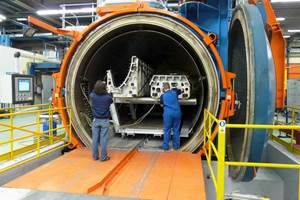3D printed tools are in production at Dassault Falcon Jet
The trend of employing polymeric additive manufacturing (AM) or 3D printing for composite tooling is growing.

This section of a large 3D printed tool is being used for part production at Falcon Jet.
The trend of employing polymeric additive manufacturing (AM) or 3D printing for composite tooling is growing. As we reported back in our July 2015 issue (here’s the link: http://www.compositesworld.com/articles/3d-printing-moves-into-tooling-components), many in the composites industry want to reduce tooling lead times to keep pace with composite part design cycles, and to keep up with accelerating manufacturing and processing speeds, across the spectrum of markets but especially in aerospace and automotive. And AM is a big enabler, since tools can be made in a matter of days or hours, and — with improving materials and build designs — stand up to autoclave cycles, in many cases.
Stratasys Inc. (Eden Prairie, MN, US), a manufacturer of direct digital manufacturing and rapid prototyping systems using Fused Deposition Modeling (FDM) technology for producing parts and tools, is working with many customers on both part and AM tooling concepts and materials, among them Dassault Falcon Jet (South Hackensack, NJ, US and Little Rock, AR, US). Tim Schniepp, director of Composite Tooling Solutions at Stratasys with extensive aerospace experience, recently introduced me to Bastien Carel and Gregory Hilbert of Dassault Falcon Jet’s composites engineering team located at Dassault Falcon Jet’s completion center in Little Rock, where the company’s business jets undergo final assembly, including wiring, painting and installation of interiors. Fifty to 70 aircraft undergo completion per year at the Little Rock facility.
First, a little background on Dassault Falcon Jet: this venerable French aviation company, which began in 1916 and just celebrated its centenary, was founded by aeronautical engineer Marcel Bloch (later known as Marcel Dassault), who first developed the two-bladed Éclair propeller and founded the Societe d’Etudes Aeronautiques (SEA) to build planes for France in World War I. Later, Bloch’s company designed and built airliners for Air France, prior to World War II. The company grew tremendously between 1945 and 1975, and was responsible for the Mirage and Mystère combat fighter jets as well as French civil aircraft. Dassault Falcon Jet is one of the leaders in the business jet segment, with the Dassault Falcon 20 making its first flight in 1963. Today the company is known for its “heavy” business jets, among the largest in the bizjet market. Notably, Marcel Dassault and his engineers helped develop computer-aided design tools for the design of the company’s aircraft, and that ultimately led to CATIA and the spinoff of software company Dassault Systèmes.
Carel and Hilbert report that they are designing and developing large tools, up to 4.6m in length, for production of honeycomb-cored composite interior fittings, including flat and curved panels, bulkheads, and aircraft lavatory wall sections. Tools are 3D printed using a Stratasys Fortus 900mc, the largest production printer currently offered by Stratasys. Material is Ultem 1010 polyetherimide (PEI), with a Tg of 420°F; raw materials are supplied by SABIC (Pittsfield, MA, US) to Stratasys to produce the final FDM filament. The tools will be produced in segments, joined in a tongue-in-groove manner and bonded with an epoxy, typically with a product such as Henkel’s (Rocky Hill, CT, US) EA9394. Says Carel, “We are trying a near-net approach to minimize any issues with joining.” Falcon Jet is experimenting now with joining and post-cure machining of the tools, to achieve the finished surface requirements, as well as sealers, to ensure vacuum integrity.
The FDM tools are capable of meeting requirements for dimensional accuracy says Carel, because the composite parts are vacuum-bagged and oven-cured at 250°F. Several rounds of test part cure cycles have been carried out so far, with “no visible flaws,” report Carel and Hilbert. Testing will continue through April, with the plan to put the 3D tools into the production process after that. Why 3D printing for tooling? Carel explains, “We are in a situation with high part variability and low volume,” in which jets receive customized interior layouts according to each customer’s specs. “We’re utilizing AM tooling as a complement to more traditional tooling. It’s not a direct competition with metal tooling, but it can be more efficient in terms of time and cost.”
Stay tuned for more developments in AM tooling. Schniepp, Hilbert and Carel all agree: in the next few years, 3D printed tooling has potential to be just as robust and production-capable as similar non-metallic tooling materials.
Related Content
Industrial composite autoclaves feature advanced control, turnkey options
CAMX 2024: Designed and built with safety and durability in mind, Akarmark delivers complete curing autoclave systems for a variety of applications.
Read MorePEEK vs. PEKK vs. PAEK and continuous compression molding
Suppliers of thermoplastics and carbon fiber chime in regarding PEEK vs. PEKK, and now PAEK, as well as in-situ consolidation — the supply chain for thermoplastic tape composites continues to evolve.
Read MorePlataine unveils AI-based autoclave scheduling optimization tool
The Autoclave Scheduler is designed to increase autoclave throughput, save operational costs and energy, and contribute to sustainable composite manufacturing.
Read MorePlant tour: Airbus, Illescas, Spain
Airbus’ Illescas facility, featuring highly automated composites processes for the A350 lower wing cover and one-piece Section 19 fuselage barrels, works toward production ramp-ups and next-generation aircraft.
Read MoreRead Next
All-recycled, needle-punched nonwoven CFRP slashes carbon footprint of Formula 2 seat
Dallara and Tenowo collaborate to produce a race-ready Formula 2 seat using recycled carbon fiber, reducing CO2 emissions by 97.5% compared to virgin materials.
Read MorePlant tour: Daher Shap’in TechCenter and composites production plant, Saint-Aignan-de-Grandlieu, France
Co-located R&D and production advance OOA thermosets, thermoplastics, welding, recycling and digital technologies for faster processing and certification of lighter, more sustainable composites.
Read More“Structured air” TPS safeguards composite structures
Powered by an 85% air/15% pure polyimide aerogel, Blueshift’s novel material system protects structures during transient thermal events from -200°C to beyond 2400°C for rockets, battery boxes and more.
Read More






















